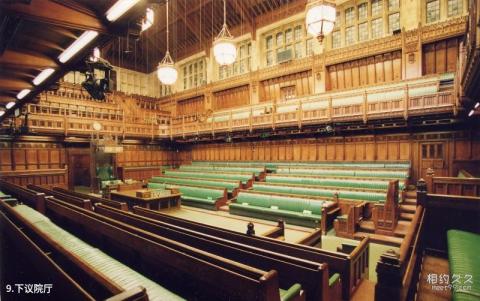
Introduction to the House of Commons Hall: The House of Commons Hall is located at the northern end of the Palace of Westminster. This hall was destroyed in the 1941 London bombing during World War II and was rebuilt with the efforts of architect Jareth Gilbert Scott. , re-opened in 1950, the hall is 14×20.7m rectangular, and is much simpler than the upper house hall; the parliamentary benches and other decorations in the hall are painted green; members of the lower house are not allowed to go to the red upper house Sit on the bench.
The Speaker's seat of the House of Commons at the north end of the hall is a replica. The original version was donated by the House of Commons after the opening ceremony of the Australian Parliament. In front of the Speaker's seat is an office seat where the record clerk sits and the scepter of the House of Commons is placed. The document delivery box was imported from New Zealand Presented as a gift, it is often placed in front of the seats of members of the House of Commons during question sessions and speeches; two rows of green seats are arranged opposite each other, with the ruling party seats on the right side of the speaker and the opposition party seats on the other side. There is no middle seat in the hall. The chamber is correspondingly smaller and can only accommodate 427 of the 646 MPs. It is only during "Prime Minister's Questions" and main debates that MPs will fill the chamber.
Traditionally, the monarch does not enter the House of Commons. The last time this happened was in 1642, when Charles I entered the chamber to search for five MPs on the grounds of serious treason. However, when he asked Speaker William Rensol about the whereabouts of the five MPs, Rensol answered the following question. A sentence: "Your Majesty the King, I have neither eyes to see nor tongue to speak. The House of Commons guides me. I am a servant here."
There are two rows of red lines 2.5 meters apart in the center of the floor. Legend has it that it was meant to be just over the length of two swords. Historically, this was done to avoid debates in the House of Commons devolving into conflict. Members of both parties were not allowed to cross this line when speaking in the House of Commons today. If a member crosses the red line when speaking, he will be reprimanded by the other party. This may also be the origin of the English expression "to toe the line".
